Enjoy our triplist below! For our tour
description, itinerary, past triplists, dates, fees, and more,
please visit our TOUR PAGE.
Click on the link at right to see this
triplist in printable PDF format with media only on
page 1.
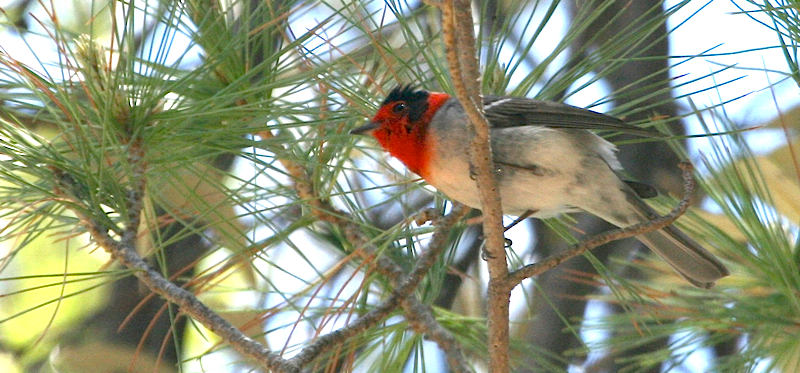
It's not surprising
that the beautiful Red-faced Warbler is a close relative of
both Red Warbler and Pink-headed Warbler of Mexico and
Central America. What is surprising is that both Canada and
Wilson's warblers have recently been added to the same
genus! Who would have thought? (Photo by guide Dave
Stejskal)
We all enjoyed another very successful "Arizona Nightbirds
& More" tour this year, and it was my 2nd run of this
short and productive itinerary in as many weeks. Weather was
pretty darned good, with a minimum of wind, and the
temperatures were quite enjoyable in the highlands.
Our sights were again set on finding as many of the breeding
species of owls and nightjars that we could in this rich
corner of the state. We weren't disappointed with our owl
tally, seeing a total of seven species very well from the
Santa Rita Mts. south of Tucson east to the west side of the
Chiricahua Mts. The prizes this year included a trio of small
owls on our first night together (Elf, plus Whiskered and
Western screech-owls), then the stately Spotted Owl and
diminutive Northern Pygmy-Owl in the Huachuca Mts. to the s.e.
of Tucson, and, finally, the highly coveted Flammulated Owl
and the widespread Great Horned Owl in the Chiricahuas. Some
were easy, and others not so much, but we came away with
memorable looks at all of them. Nightjars were another issue,
with Lesser Nighthawk and Common Poorwill making the 'seen'
list, but satisfying ourselves with excellent audio only for
the recently split Mexican Whip-poor-will.
Traveling to the canyons, creeks, and mountains that secret
away these many nightbird species necessarily gets you into
habitat for a number of prized Southeast Arizona specialty
species, and we did well again with these this year. A
wandering female White-eared Hummingbird in Madera Canyon was
arguably the best of these, but we also scored on seven other
species of hummingbirds, a nesting Gray Hawk, Elegant Trogon
for a few of us, multiple Arizona Woodpeckers, a fine
selection of local flycatchers including a final hour
Thick-billed Kingbird, outstanding Mexican Chickadee, an
excellent slate of specialty warblers including Red-faced, the
local Rufous-winged and Botteri's sparrows, and the
distinctive Yellow-eyed Junco.
Thanks to each of you for joining me on this short but
extremely enjoyable tour to an area that I consider to be my
'back yard'. It's a region of the world that I never tire of.
Enjoy the long summer and I hope to see all of you on an
upcoming tour again soon!
--Dave
For more information about this tour, including future
departures, visit our website at www.fieldguides.com.
And to see this same triplist online, go to https://fieldguides.com/triplists/azn12bLIST.pdf
and you will find the list in its entirety.
KEYS FOR THIS LIST
One of the following keys may be shown in brackets for
individual species as appropriate: * = heard only, I =
introduced, E = endemic, N = nesting, a = austral migrant, b =
boreal migrant
Anatidae (Ducks, Geese, and Waterfowl)
MALLARD (NORTHERN) (Anas platyrhynchos platyrhynchos)
MALLARD (MEXICAN)
(Anas platyrhynchos diazi)
BLUE-WINGED TEAL
(Anas discors)
NORTHERN SHOVELER
(Anas clypeata)
Odontophoridae (New World Quail)
SCALED QUAIL (Callipepla squamata)
GAMBEL'S QUAIL
(Callipepla gambelii)
[N]
Phasianidae (Pheasants, Grouse, and
Allies)
WILD TURKEY (Meleagris gallopavo)
Ardeidae (Herons, Egrets, and Bitterns)
GREAT BLUE HERON (Ardea herodias) [N]
CATTLE EGRET
(Bubulcus ibis)
Threskiornithidae (Ibises and Spoonbills)
WHITE-FACED IBIS (Plegadis chihi)
Cathartidae (New World Vultures)
BLACK VULTURE (Coragyps atratus)
TURKEY VULTURE
(Cathartes aura)
Accipitridae (Hawks, Eagles, and Kites)
COOPER'S HAWK (Accipiter cooperii) [N]
GRAY HAWK (Buteo nitidus) [N]
SWAINSON'S HAWK
(Buteo swainsoni)
RED-TAILED HAWK
(Buteo jamaicensis)
Charadriidae (Plovers and Lapwings)
KILLDEER (Charadrius
vociferus) [N]
Scolopacidae (Sandpipers and Allies)
SPOTTED SANDPIPER (Actitis macularius)
Columbidae (Pigeons and Doves)
ROCK PIGEON (Columba livia) [I]
BAND-TAILED PIGEON
(Patagioenas fasciata)
EURASIAN
COLLARED-DOVE (Streptopelia
decaocto) [I]
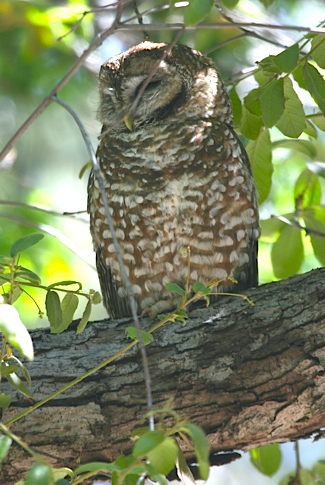
Once again we had
the much sought-after Spotted Owl on two consecutive days,
giving everyone in the group super views of this prized
bird! (Photo by guide Dave Stejskal)
WHITE-WINGED DOVE (Zenaida asiatica)
MOURNING DOVE
(Zenaida macroura)
INCA DOVE (Columbina inca)
Cuculidae (Cuckoos)
GREATER ROADRUNNER (Geococcyx californianus)
Strigidae (Owls)
FLAMMULATED OWL (Otus flammeolus)
WESTERN
SCREECH-OWL (Megascops
kennicottii)
WHISKERED
SCREECH-OWL (Megascops
trichopsis)
GREAT HORNED OWL
(Bubo virginianus)
NORTHERN PYGMY-OWL
(Glaucidium gnoma) [N]
ELF OWL (Micrathene whitneyi)
SPOTTED OWL
(Strix occidentalis)
Caprimulgidae (Nightjars and Allies)
LESSER NIGHTHAWK (Chordeiles acutipennis)
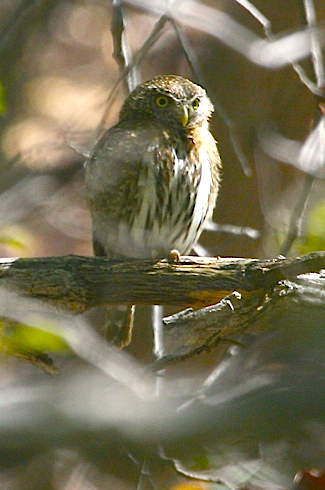
Though not much
bigger than some of the small Passerines it hunts, the
Northern Pygmy-Owl is one fierce little bird. We had great
looks at this one at an active nest hole in Scheelite
Canyon. (Photo by guide Dave Stejskal)
COMMON POORWILL (Phalaenoptilus nuttallii)
MEXICAN
WHIP-POOR-WILL (Caprimulgus
arizonae arizonae) [*]
Apodidae (Swifts)
WHITE-THROATED SWIFT (Aeronautes saxatalis)
Trochilidae (Hummingbirds)
MAGNIFICENT HUMMINGBIRD (Eugenes fulgens)
BLUE-THROATED
HUMMINGBIRD (Lampornis
clemenciae)
BLACK-CHINNED
HUMMINGBIRD (Archilochus
alexandri)
ANNA'S HUMMINGBIRD
(Calypte anna)
BROAD-TAILED
HUMMINGBIRD (Selasphorus
platycercus)
BROAD-BILLED
HUMMINGBIRD (Cynanthus
latirostris)
VIOLET-CROWNED
HUMMINGBIRD (Amazilia
violiceps)
WHITE-EARED
HUMMINGBIRD (Hylocharis
leucotis)
Trogonidae (Trogons)
ELEGANT TROGON (Trogon elegans)
Picidae (Woodpeckers)
ACORN WOODPECKER (Melanerpes formicivorus)
GILA WOODPECKER
(Melanerpes uropygialis)
LADDER-BACKED
WOODPECKER (Picoides scalaris)
HAIRY WOODPECKER
(Picoides villosus) [*]
ARIZONA WOODPECKER
(Picoides arizonae) [N]
NORTHERN FLICKER
(RED-SHAFTED) (Colaptes
auratus cafer)
GILDED FLICKER
(Colaptes chrysoides) [*]
Tyrannidae (Tyrant Flycatchers)
NORTHERN BEARDLESS-TYRANNULET (Camptostoma imberbe)
OLIVE-SIDED
FLYCATCHER (Contopus cooperi)
GREATER PEWEE
(Contopus pertinax)
WESTERN WOOD-PEWEE
(Contopus sordidulus)
HAMMOND'S
FLYCATCHER (Empidonax
hammondii)
GRAY FLYCATCHER
(Empidonax wrightii)
CORDILLERAN
FLYCATCHER (Empidonax
occidentalis)
BUFF-BREASTED
FLYCATCHER (Empidonax
fulvifrons)
SAY'S PHOEBE
(Sayornis saya)
VERMILION
FLYCATCHER (Pyrocephalus
rubinus)
DUSKY-CAPPED
FLYCATCHER (Myiarchus
tuberculifer)
ASH-THROATED
FLYCATCHER (Myiarchus
cinerascens)
BROWN-CRESTED
FLYCATCHER (Myiarchus
tyrannulus)
CASSIN'S KINGBIRD
(Tyrannus vociferans)
THICK-BILLED
KINGBIRD (Tyrannus
crassirostris)
WESTERN KINGBIRD
(Tyrannus verticalis)
Laniidae (Shrikes)
LOGGERHEAD SHRIKE (Lanius ludovicianus)
Vireonidae (Vireos)
PLUMBEOUS VIREO (Vireo plumbeus) [N]
CASSIN'S VIREO
(Vireo cassinii)
HUTTON'S VIREO
(Vireo huttoni)
WARBLING VIREO
(Vireo gilvus)
Corvidae (Crows, Jays, and Magpies)
STELLER'S JAY (Cyanocitta stelleri)
WESTERN SCRUB-JAY
(WOODHOUSE'S) (Aphelocoma
californica woodhouseii)
MEXICAN JAY
(Aphelocoma wollweberi)
CHIHUAHUAN RAVEN
(Corvus cryptoleucus)
COMMON RAVEN
(Corvus corax)
Alaudidae (Larks)
HORNED LARK (Eremophila alpestris)
Hirundinidae (Swallows)
NORTHERN ROUGH-WINGED SWALLOW (Stelgidopteryx serripennis)
VIOLET-GREEN
SWALLOW (Tachycineta
thalassina)
BARN SWALLOW
(Hirundo rustica)
CLIFF SWALLOW
(Petrochelidon pyrrhonota) [N]
Paridae (Chickadees and Tits)
MEXICAN CHICKADEE (Poecile sclateri)
BRIDLED TITMOUSE
(Baeolophus wollweberi)
Aegithalidae (Long-tailed Tits)
BUSHTIT (Psaltriparus
minimus)
Sittidae (Nuthatches)
WHITE-BREASTED NUTHATCH (Sitta carolinensis)
Troglodytidae (Wrens)
CACTUS WREN (Campylorhynchus brunneicapillus)
CANYON WREN
(Catherpes mexicanus) [*]
BEWICK'S WREN
(Thryomanes bewickii)
HOUSE WREN
(Troglodytes aedon)
Polioptilidae (Gnatcatchers)
BLUE-GRAY GNATCATCHER (Polioptila caerulea)
BLACK-TAILED
GNATCATCHER (Polioptila
melanura)
Turdidae (Thrushes and Allies)
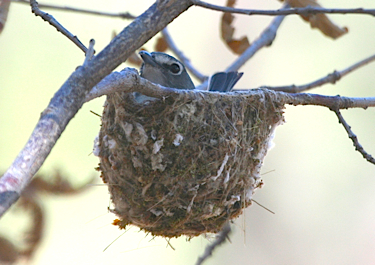
A Plumbeous Vireo
peers over the rim of its beautifully woven nest in the
upper Carr Canyon. (Photo by guide Dave Stejskal)
SWAINSON'S THRUSH (Catharus ustulatus)
HERMIT THRUSH
(Catharus guttatus)
AMERICAN ROBIN
(Turdus migratorius)
Mimidae (Mockingbirds and Thrashers)
NORTHERN MOCKINGBIRD (Mimus polyglottos)
BENDIRE'S THRASHER
(Toxostoma bendirei)
CURVE-BILLED
THRASHER (Toxostoma
curvirostre)
Sturnidae (Starlings)
EUROPEAN STARLING (Sturnus vulgaris) [I]
Ptilogonatidae (Silky-flycatchers)
PHAINOPEPLA (Phainopepla nitens)
Parulidae (New World Warblers)
ORANGE-CROWNED WARBLER (Oreothlypis celata)
LUCY'S WARBLER
(Oreothlypis luciae)
VIRGINIA'S WARBLER
(Oreothlypis virginiae)
MACGILLIVRAY'S
WARBLER (Geothlypis tolmiei)
COMMON
YELLOWTHROAT (Geothlypis
trichas)
AMERICAN REDSTART
(Setophaga ruticilla) [*]
YELLOW WARBLER
(Setophaga petechia) [*]
YELLOW-RUMPED
WARBLER (AUDUBON'S) (Setophaga
coronata auduboni)
GRACE'S WARBLER
(Setophaga graciae)
BLACK-THROATED
GRAY WARBLER (Setophaga
nigrescens)
TOWNSEND'S WARBLER
(Setophaga townsendi)
WILSON'S WARBLER
(Cardellina pusilla)
RED-FACED WARBLER
(Cardellina rubrifrons)
PAINTED REDSTART
(Myioborus pictus)
[N]
YELLOW-BREASTED
CHAT (Icteria virens)
Emberizidae (Buntings, Sparrows and
Allies)
SPOTTED TOWHEE (Pipilo maculatus)
RUFOUS-CROWNED
SPARROW (Aimophila ruficeps)
CANYON TOWHEE
(Melozone fusca)
ABERT'S TOWHEE
(Melozone aberti)
RUFOUS-WINGED
SPARROW (Peucaea carpalis)
BOTTERI'S SPARROW
(Peucaea botterii)
CHIPPING SPARROW
(Spizella passerina)
BREWER'S SPARROW
(Spizella breweri)
LARK SPARROW
(Chondestes grammacus)
BLACK-THROATED
SPARROW (Amphispiza bilineata)
GRASSHOPPER
SPARROW (Ammodramus
savannarum)
SONG SPARROW
(Melospiza melodia)
WHITE-CROWNED
SPARROW (MOUNTAIN) (Zonotrichia
leucophrys oriantha)
WHITE-CROWNED
SPARROW (GAMBEL'S) (Zonotrichia
leucophrys gambelii)
YELLOW-EYED JUNCO
(Junco phaeonotus)
Cardinalidae (Cardinals and Allies)
HEPATIC TANAGER (Piranga flava)
SUMMER TANAGER
(Piranga rubra)
WESTERN TANAGER
(Piranga ludoviciana)
NORTHERN CARDINAL
(Cardinalis cardinalis) [*]
PYRRHULOXIA
(Cardinalis sinuatus)
ROSE-BREASTED
GROSBEAK (Pheucticus
ludovicianus)
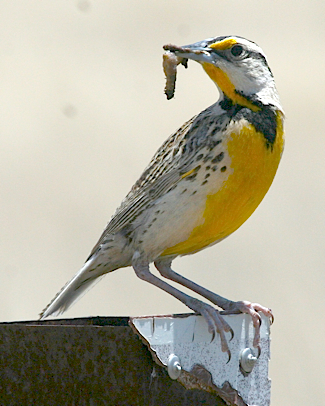
This pale desert
form of Eastern Meadowlark is sometimes treated as a
separate species, Lilian's Meadowlark. We had some great
looks in the Sonoita Grasslands. (Photo by guide Dave
Stejskal)
BLACK-HEADED GROSBEAK (Pheucticus melanocephalus)
LAZULI BUNTING
(Passerina amoena)
Icteridae (Troupials and Allies)
RED-WINGED BLACKBIRD (Agelaius phoeniceus)
EASTERN MEADOWLARK
(LILIAN'S) (Sturnella magna
lilianae)
YELLOW-HEADED
BLACKBIRD (Xanthocephalus
xanthocephalus)
GREAT-TAILED
GRACKLE (Quiscalus mexicanus)
BROWN-HEADED
COWBIRD (Molothrus ater)
HOODED ORIOLE
(Icterus cucullatus)
BULLOCK'S ORIOLE
(Icterus bullockii)
Fringillidae (Siskins, Crossbills, and
Allies)
HOUSE FINCH (Carpodacus mexicanus)
LESSER GOLDFINCH
(Spinus psaltria)
Passeridae (Old World Sparrows)
HOUSE SPARROW (Passer domesticus)
DESERT COTTONTAIL
(Sylvilagus audubonii)
LEAST CHIPMUNK
(Tamias minimus)
ROCK SQUIRREL
(Spermophilus variegatus)
ROUND-TAILED
GROUND SQUIRREL (Spermophilus
tereticaudus)
ARIZONA GRAY
SQUIRREL (Sciurus arizonensis)
COLLARED PECCARY
(Tayassu tajacu)
WHITE-TAILED DEER
(Odocoileus virginianus)
PRONGHORN (Antilocapra americana)
Totals for the tour: 149 bird taxa and 8 mammal taxa





